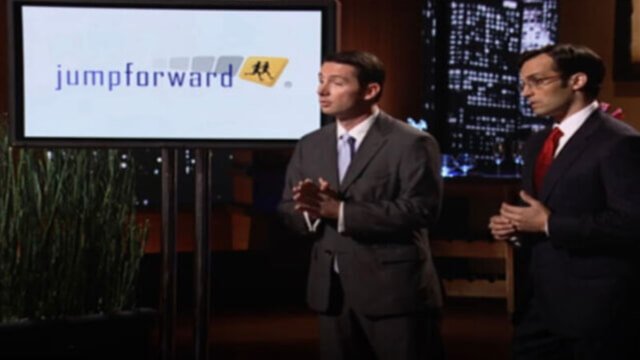Let’s bust a Shark Tank myth right out of the gate—just because you see hands shake on TV doesn’t mean the money ever hits your account. JumpForward’s episode on Season 1 is the kind of story every founder needs to see. Not just for the ask and the deal drama, but for what comes after the credits. Tech, college sports, big-money offers…the JumpForward saga checks every box. But the real lesson? Sometimes saying no, thanks to shark money, is how you win.
Contents
ToggleWhat Is JumpForward—and Why Should Entrepreneurs Pay Attention?
Before TikTokers were hawking side hustles and SaaS deals, Brian Duggan and Adam McCombs saw a pain point screaming for a solution: college sports recruiting. Coaches needed a slicker, legal way to communicate, track compliance, and help athletes connect with programs. Old methods were clunky and riddled with risk (lost emails, missed deadlines, NCAA nightmares). JumpForward came in swinging with a straightforward platform—cloud-based, athlete-centric, and built for athletic departments that craved efficiency.
Why should you care? Because they solved a real problem, one coaches and athletes would pay to kill. And on the surface, they looked like perfect Shark bait.
Meet the Founders: Brian Duggan and Adam McCombs
This wasn’t their first rodeo. Brian Duggan was a hustler—business-minded and tech-savvy. Adam McCombs brought hardcore technical chops, plus a knack for listening to coaches’ actual needs.
I’ve seen too many founders pitch ideas nobody wanted. These two built JumpForward because they’d lived the pain and heard it from the people who’d pay for a solution. That’s the difference between a cool idea and a real company.

The Shark Tank Pitch: Ask, Product, and First Impressions
Here’s what went down on Shark Tank Season 1, Episode 10: Brian and Adam pitched JumpForward asking for $150,000 in exchange for 10% of the company (a $1.5 million valuation—confidence, but not pure fantasy). Their product? A platform making recruiting simple, legal, and way less time-intensive for college athletic departments.
No hype. No gimmicks. Just clear software saving time and compliance headaches. You know what got the Sharks interested? Revenue in hand, a growing user base, and a problem every coach in America recognized.
Personally, I’ve watched founders swirl around and give wild projections. These two came into the pitch room prepared, measured, but willing to stand their ground.
Shark Negotiations: Who Bit? How Did the Chess Match Go Down?
This episode is a masterclass in negotiation. After hearing the pitch:
- Kevin O’Leary came in hot: $200,000 for 20% equity. Not the worst—he wanted more skin in the game.
- Robert Herjavec upped the ante: $300,000 for 35%. Robert sees potential, but wants a big chunk.
- But hang on. The real drama? O’Leary and Herjavec team up and drop a bomb: $400,000 for 50%.
Let’s break this play down. That’s four times the ask, but for half the company. That’s a controlling stake, for two Sharks who’ve never run a recruiting platform in their lives.
You see founders get shark drunk and sell half their dreams to a TV-friendly handshake—often a huge mistake. Brian and Adam? They didn’t say yes on the spot. They played it cool and walked away to consider. I’ve seen greed kill deals, but holding out for better means you really know your value.

Net Worth and Valuation: What Was JumpForward Worth—And Did the Sharks Get It Right?
On camera, JumpForward’s $1.5 million valuation raised some eyebrows—especially for Season 1, when SaaS wasn’t as sexy as it is now. But think about it: recurring revenue, big names (colleges as clients), and a renewal rate most B2B founders would fight for.
Were the Sharks lowballing with 50% for $400K? Of course. But this is what they do. Control is leverage; don’t let the drama fool you.
JumpForward understood that. They had traction and knew there were more ways to win than taking the first TV money thrown at them. This isn’t your classic Scrub Daddy hyper-growth rocket, but it’s sticky, niche, and valuable. As later events showed, sometimes your true net worth isn’t realized until you exit.
The Outcome: What Happened After the Cameras Stopped Rolling?
Here’s the part Shark Tank fans rarely see—most deals never close. After the show? No handshake. O’Leary and Herjavec’s offer fizzled during due diligence (happens all the time—one reason you should read the fine print).
Did JumpForward fold? Not a chance. They doubled down on the product. They went mobile, evolved features, and, more importantly, let their client retention stats do the talking. When you renew 99% of customers year after year, you own your market—even if you didn’t close with a Shark.
Too many founders want to wear that Shark-backed badge. Brian and Adam took the exposure and ran their play, not Shark Tank’s.
Growth and Exit: Where Did JumpForward Land?
Here’s where their story outshines most Shark Tank stars. After the show, JumpForward scaled up:
- They launched a mobile app, making recruiting easier on the go.
- They landed over 150 college customers—think about the repeat, institutional revenue there.
- Retention? 99% yearly renewal—outrageous for any SaaS, B2B, or subscription business.
And then, the win founders dream about: a buyout. In 2016, Active Network acquires JumpForward. Purchase price? Not public, but you don’t get scooped up by a major player unless you’re bringing value and leverage. Some companies ride a Shark’s coattails, others build a business Sharks will wish they’d invested in. JumpForward is the latter.
Where Are the Founders Now?
Let’s look at Brian Duggan and Adam McCombs since the exit. Spoiler: they didn’t retire on a beach. These are founders who build and keep building.
- Brian Duggan is now founder and CEO of Livly—a property management tech company that solves headaches for landlords and tenants (spot the pattern?).
- Adam McCombs became Chief Product Officer at Vantaca. Again, real estate tech, fixing pain points for big institutions.
What’s this tell you? Founders who truly get the grind and tech don’t sit still. They spot inefficiencies, create platforms, and keep moving.
Real Shark Tank Lessons: What Founders Can Steal from the JumpForward Playbook
Here’s what you should steal from their playbook:
- Exposure matters—but only if your business is real. JumpForward had deals lined up, actual contracts, and a sticky product. Shark Tank was a launchpad, not the whole story.
- Don’t sell for TV drama. A 50% offer for double what you wanted sounds good on TV…until you’re left working for someone else’s gain.
- Obsess over renewals. Recurring, institutional revenue with 99% retention? That’s the quiet genius move most consumer invention pitches never hit.
- Don’t pivot for a Shark. Investors may want to change your business overnight. Sometimes the best move is to stick with your plan and grow it yourself.
- Keep building after the win (or the loss). The acquisition may be the headline, but it’s what the founders did after that proves their startup mettle.
To anyone dreaming of Shark Tank fame, take note—JumpForward played the long game. TV deals come and go. Building a business that survives Shark Tank and lands a real exit will always be rare air.
FAQs — Straight Answers from SharkWorth
1. Is JumpForward still in business today?
No, not as an independent brand. It was acquired by Active Network back in 2016.
2. Did JumpForward actually get Shark Tank funding?
No. The on-air deal with Kevin O’Leary and Robert Herjavec never closed after the show.
3. How much was JumpForward sold for?
The sale amount was never made public, but a SaaS company with their retention likely banked a strong exit.
4. What problem did JumpForward solve?
It made college sports recruiting fast, legal, and easy for universities, cutting compliance horror stories and wasted hours.
5. Who leads the company now after the acquisition?
Active Network owns and manages the platform. Both founders moved on to new startups.
6. Are the founders still in sports tech?
Not directly. Brian runs Livly (property management tech), Adam is Chief Product Officer at Vantaca (real estate management SaaS).
7. What did the Sharks think of JumpForward’s business model?
Kevin and Robert saw real opportunity, but they wanted control. JumpForward knew what they were worth and didn’t bite.
8. Was the Shark Tank appearance worth it for JumpForward?
Absolutely. They got exposure, validation, and proved you don’t need a Shark’s money to scale or sell.
Final Word — Would I Have Made the Same Call?
Let’s be blunt. Sharks can shine a light and open doors. But giving up half your company to two guys outside your industry isn’t always smart money. JumpForward’s founders read the room, trusted the numbers, and built a company too valuable for TV drama.
If you’re serious about winning the long game, learn from JumpForward. Exposure is nice, but leverage and execution score the real wins. The story you write after the pitch means everything.
On SharkWorth, we track the real hustle—not just the TV handshake.










